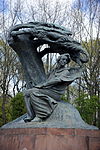The Polish People's Republic (Polish: Polska Rzeczpospolita Ludowa, PRL) was a country in Central Europe that existed from 1947 to 1989 as the predecessor of the modern Republic of Poland. With a population of approximately 37.9 million near the end of its existence, it was the second most-populous communist and Eastern Bloc country in Europe. Having a unitary Marxist–Leninist government, it was also one of the main signatories of the Warsaw Pact alliance. The largest city and official capital since 1947 was Warsaw, followed by the industrial city of Łódź and cultural city of Kraków. The country was bordered by the Baltic Sea to the north, the Soviet Union to the east, Czechoslovakia to the south, and East Germany to the west.
Between 1952 and 1989 Poland was ruled by a communist government established after the Red Army's takeover of Polish territory from German occupation in World War II. The state's official name was the "Republic of Poland" (Rzeczpospolita Polska) between 1947 and 1952 in accordance with the transitional Small Constitution of 1947. The name "People's Republic" was introduced and defined by the Constitution of 1952. Like other Eastern Bloc countries (East Germany, Czechoslovakia, Hungary, Romania, Bulgaria and Albania), Poland was regarded as a satellite state, with independence in internal affairs yet subordination to the USSR in international politics.
The Polish United Workers' Party became the dominant political party in the Polish People's Republic, officially making it a socialist country. During this period Poland was a de facto one-party state but it had more liberal policies than other states in the Eastern Bloc. Since its inception, the Polish People's Republic was characterized by constant internal struggles for multi-party democracy as opposed to democratic centralism. Throughout its existence, economic hardships and social unrest were common in almost every decade. The nation was split between those who supported the party, those who were opposed to it and those who refused to engage in political activity. Despite this, some groundbreaking achievements were established during the tenure of the Polish People's Republic such as; improved living conditions, rapid industrialization, urbanization, access to universal health care, and higher education. The Polish People's Republic also implemented policies that virtually eliminated homelessness and established a job guarantee. As a result Poland's population almost doubled between 1947 and 1989. Some of the party's most remarkable accomplishments were the complete rebuilding of ruined Warsaw after World War II and creating a fully literate population.Although the Polish People's Republic maintained a standing army, it did host Soviet troops in its territory, as Poland was a Warsaw Pact signatory. The Soviet Union maintained a military presence in all signatories of the Warsaw Pact. The UB and succeeding SB were the chief intelligence agencies that acted as secret police, similar to the East German Stasi and Soviet KGB. The official police organization, which was also responsible for peacekeeping and suppression of protests. This force, called the Citizen's Militia, resulted in communist Poland having one of the lowest crime rates in the world.











